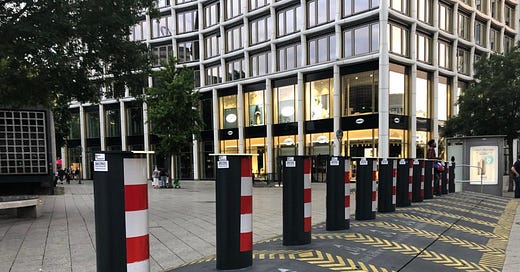Like so many people around the world, I was deeply saddened by the recent events in Magdeburg, where yet another attack on a German Christmas market resulted in death and carnage. Admittedly, there are still many questions to be answered about the perpetrator, but the reality that life in Germany has been irrevocably changed by large-scale, and virtually uncontrolled, migration from the Muslim world (the Magdeburg killer has a Saudi background) cannot be doubted.
One image that still haunts me, after a recent visit to Berlin, is that of a barrier. On the surface, it looks like nothing more than a heavy-duty traffic control device. However, it is deeply symbolic of the situation in many Western nations, especially given its iconic location.
Kurfurstendamm in the west of Berlin used to be called the ‘Window on the West’. A place where the citizens of the east, if they made it that far, could view the economic prosperity achieved under western freedoms. On the surface little has changed. The KDW, one of the largest department stores in the world, is still there. On the evening I visited, an 80’s band was belting out familiar tunes while smiling shoppers danced or simply watched. But in this city, famous for the wall that divided it, they were doing so protected by this barrier.
Why this might be so becomes clear as you walk towards the Kaiser Wilhelm church. On its steps are candles, flickering in red plastic containers. They stand in front of black and white portraits of people whose own smiling faces were wiped out at this very place. You see, it was here that 19 people were killed (with 56 injured) during the Christmas Market truck attack on 19 December 2016. The ISIS inspired terrorist, Anis Amri, was a Tunisian asylum seeker who was in Germany as a result of its famously open attitude towards refugee settlement.
In the aftermath of the attack ugly concrete barriers (derisively known as ‘Merkel’s Marbles’) went up around the Ku’damm and other high-profile targets. They were hideous to look at, but at least they gave the impression that they were there to deal with a temporary emergency. This new barrier, on the other hand, spoke of permanence. It even has a brand name ‘TruckBloc’ and is manufactured by a company specializing in this sort of thing.
The irony could not be greater. In a city once divided by the ultimate in barriers, new barriers, seemingly no less permanent, are emerging. All the while the German people are actively discouraged from talking about why this might be so, let alone naming the ideology that made ‘Truck Bloc’s’ necessary at the heart of this symbol of western freedom. In the case of the Magdeburg attack, even the heavy duty traffic control measures were not enough to protect the people of Magdeburg, as the perpetrator found ways to circumvent them.
The simple reality is that societies that do not take care to protect their citizens by carefully inquiring into the motives of those who enter will be forced to erect ever more ‘interior borders’ to keep their people at least somewhat safe.
The ‘Truckbloc’ barriers, bright and shining, yet also deeply sinister, made me resolve to redouble my efforts to act as a warner and truth-teller. May you do the same.
For a thoroughgoing analysis of the links between Islamic teaching and violence, please see my book ‘Nothing to do with Islam - Investigating the West’s Most Dangerous Blind Spot’
Kind regards,
Peter
Please be so kind as to share this message with your friends:
Click the button below to subscribe (or to upgrade to a paid subscription):




